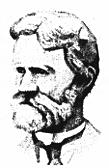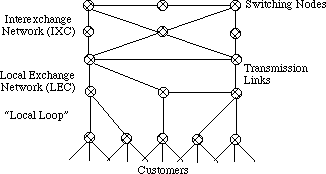 Bell and Edison
Bell and Edison10 March 1876: first demonstration of electronic transmission of speech by Alexander Graham Bell.
Bell was born in Edinburgh Scotland in 1847. Family moves to Canada and later Boston. Becomes Professor of Vocal Physiology at Boston University: teacher of deaf children, disproving commonly held theory that the deaf could not be taught to speak.
The Basic Invention: magnetic induction method. Thin iron diaphragm in front of an iron core surrounded by a coil of wire. Sound waves hitting the core cause it to vibrate in the magnetic field, inducing an electric current in the surrounding wire coil. This is transmitted by wires to the receiver, where the current variations induce a magnetic field, move the receiver's core, and cause the diaphragm to vibrate.
Bell's first patent, #174,465, of March 1876. Original magnetic induction method replaced by variable resistance circuits. Changes in resistance induce changes in current and vice versa.
Exhibited at the US Centenary Celebration at Philadelphia, July 1876. Operating in only one direction and over only a few hundred feet of twisted pair wires!
Thomas Edison's improvement: carbon granule transmitter. Better sensitivity than Bell's. Aluminum alloy diaphragm, sealed section with a sandwich of front carbon, carbon granuales, and back carbon.
1877: Bell offers to sell out to the Western Union company for $100,000. They refuse. Bell Telephone company founded 9 July 1877.
1878: Western Union enters competition with Bell, using equipment designed by Thomas Edison and Elisha Gray. Bell sues Western Union for patent infringement and wins in 1879. Western Union leaves the telephone business.
For Charles Dickens' view of the Patent Office in England at this time, click here.
Bell's patents expire in early 1890s. Virtually anyone can build telephone handsets. 6000 independent telephone companies spring up. Challenge is to interconnect them.
American Telephone and Telegraph (AT&T) formed to provide long distance service. Becomes parent company of the Bell System in 1900.
Switches: start out as peg boards manually establishing connections by telephone operators. Are eventually replaced by mechanical systems.
 1889:
Almon Brown Strowger (1839 - 1902). Invents the "girl-less, cuss-less"
telephone system. His invention consists of:
1889:
Almon Brown Strowger (1839 - 1902). Invents the "girl-less, cuss-less"
telephone system. His invention consists of:
Not widely deployed by the Bell System until the 1920s. Switches grow to capacity of 100,000 connections.
Early days of telephony were really a construction business: iron wires, copper wires, twisted pair to carry ground signal, wooden poles, and subterranean cables.
Characterized by many independent operators. Subscribers to different service providers could not call each other even if in they were in the same town. No rules of interconnection existed, long distance "toll" calls were very rare, and the result was chaos.
1913: AT&T and the U. S. government reached the famous Kingsbury Agreement; AT&T becoming synonomous with a national telephone network in return for regulated monopoly status and the promise to deliver "universal" telephone service. In 1910, Bell System owns 50% of the telephone access market. Competing companies exist in some large Urban areas well into 1920s/30s. Long distance interconnection withheld as a competitive weapon. By 1950, Bell System owns 84% of the local telephone access market.
1950s: Two thirds of all residential lines in US still party lines. Unified network signaling first exposed to subscribers, allowing them to make direct distance dialing (DDD) long distance telephone calls.
1950s-1970s: Rapid extension of the long-distance phone network made possible by the rise of digital, more highly automated techniques.

1980s: Deregulation
1990s: New access technologies--fiber and wireless.
Wires and cables, especially between cities, were expensive; many of the early innovations were directed towards carrying multiple conversations on the same set of wires
Multiple telephone or telegraph signals transmitted over same wire. Each sent on carrier wave of differing frequency. Receiving end uses "wave filter" tuned to carrier frequency to extract the original signals.
1875/1876: Alexander Graham Bell uses tuned vibrating reeds to demonstrate the concept for multiple simultaneous transmission of telegraph messages using mechanical rather then electronic resonance.
1890s: Michael Pupin, Columbia University, developed tuned resonating electronic circuits. Used for multichannel telephony circuits.
Basic elements of the system:
Required the invention of the triode/audion value in the 1900s before it could really become widely used.
1853: Duplex circuit allowing a telegraph message to be received while one was also being sent.
1874: Thomas Edison develops duplex and quadraplex circuits--up to four messages on a single wire
1874: French Telegrapher Emile Baudot invents time division multiplexing
Soon after his electrical telephone, Bell invented a "photophone" that allowed wireless communications using reflected light beams.
1920s: Technological developments coming together to make mobile communications possible. Driven by military and police applications, design challenges imposed by the size and power constraints of mobile transmitters, and the rise of frequency modulation (FM).
1921: Detroit first to experiment with police car dispatch via radio. Initially the system operated in one way only, with transmission from a centralized transmitter to the police cars. Transmission from vehicles was difficult: need to make transmitters small enough with small enough power demands to be transportable.
1930s: development of 2-way police radio systems. First deployed in Bayonne, N.J. Half-duplex ("push to talk") communications to compensate for high power transmitter in close proximity to highly sensitive receiver in the vehicle.
1934: Federal Communications Commission founded. First crisis: allocating sufficient bandwidth for law enforcement users.
1935: Armstrong invented frequency modulation. Virtually eliminated background static and required much less transmission power, thus enabling lower powered vehicular transmitters and receivers. FM also has ability to "capture" or lock on to the stronger signal in the same band, and is more tolerant of mobile propagation problems like fast fading.
World War II: rapid development of mobile radio technology. The need for hundred of thousands of portable communicators accelerated advances in system packaging, reliability improvements, and cost reductions. The war played a critical role in stimulating the development of a commercial FM manufacturing ability.
1946: AT&T received first mobile telephone license, for St. Louis. The initial car phone systems depended upon a single centralized transmitter to cover a whole metropolitan area. The original technology encoded the 3 kHz human voice signal in 120 KHz of wireless spectrum. The Improved Mobile Telephone Service (IMTS) provided full duplex, increasingly narrow band FM, with full interoperation with the wireline telephone system. Spectrum utilization was eventually improved by a factor of four, to 30 KHz, by the 1970s. However, the result was far from able to keep up with demand. Even in 1976, the New York area could support only 543 users, with 3700 users on the wait list.
Bell Labs engineers refining the design of the cellular telephone system. Many small transmitters, spread out to cover a geographical service area. System capacity improved by reusing the allocated spectrum on a cell by cell basis. However, this adds the extra implementation complexity of hand off.
Competition with broadcast applications for access to spectrum.
1947: AT&T proposed to the FCC the establishment of 40 MHz of spectrum for urban mobile telephony anywhere between 100 MHz and 450 MHz. Unfortunately, no unused spectrum was available.
1949, FCC considers how to allocate the UHF spectrum from 470 - 890 MHz. AT&T proposed an allocation for mobile telephony, but the FCC decided in favor of UHF TV.
1958: AT&T proposed 75 MHz for mobile telephony in the 800 MHz region; FCC does not act.
1968: FCC considering the reallocation of UHF channels 70-84 to mobile telephony. AT&T proposed the cellular system. A number of presentations over a three year period, formal filing by AT&T in December 1971.
Further deliberations by the FCC over the next twelve years did. At one point, allocations of 115 MHz (75 MHz for telephony and 40 MHz for "dispatch radio") are considered, but there were no allocations made until 1983.
During this time, FCC allowed two experimental systems to be established, one by Motorola in DC area and one by AT&T in Chicago. The Motorola experimental system remained relatively small, but the Chicago experimental system grew to cover the metro area and to serve many thousands of users.
1983: FCC finally allocated the spectrum. AT&T system in Chicago became first commercial cellular system in the U.S.